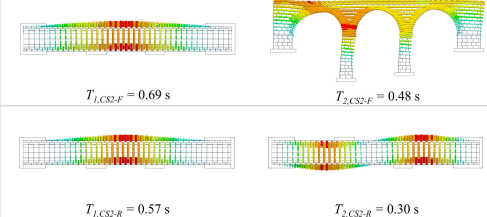Nicolò Damiani, Alessia Furiosi, Maria Rota, and Andrea Penna
i Postdoctoral Researcher, Department of Civil Engineering and Architecture (DICAr), University of Pavia, Pavia, Italy, nicolo.damiani@unipv.it
ii Ph.D. Candidate, Department of Civil Engineering and Architecture (DICAr), University of Pavia, Pavia, Italy, alessia.furiosi01@universitadipavia.it
iii Researcher, European Centre for Training and Research in Earthquake Engineering (EUCENTRE), Pavia, Italy, maria.rota@eucentre.it
iv Full Professor, Department of Civil Engineering and Architecture (DICAr), University of Pavia, Pavia, Italy, andrea.penna@unipv.it
ABSTRACT
Thousands of masonry arch bridges are still in operation today, forming a vital part of the railway and road networks in Italy and Europe. As most of these bridges were built over a century ago, issues such as material deterioration, lack of maintenance, as well as increased axle loads and traffic volumes have raised concerns about their long-term structural integrity. In earthquake-prone regions, the integrity of these structures is also challenged by loads induced by seismic activity. Within this context, an increasing number of existing masonry bridges in Italy have been incorporated into the national Seismic Observatory of Structures. This initiative aims to monitor oscillations caused by earthquakes, providing the technical and scientific community with fundamental data to understand the seismic response of these structures. This paper presents three-dimensional models of two existing masonry arch bridges, developed using an advanced modeling strategy based on the discrete element method. Located in Northern and Southern Italy, these bridges are constructed from regular stone masonry and are characterized by multiple consecutive arch vaults. The complete bridge structures are modeled as assemblies of discrete blocks, incorporating all structural and non-structural components, such as piers, abutments, arch vaults, spandrel walls, and backfill material. The geometric characteristics of the bridges and mechanical properties of the materials were assigned based on available in-situ surveys. The numerical dynamic behavior of the generated models is compared and validated against monitoring data collected from these structures, also investigating the effects of alternative boundary conditions at the bridge extremities. Nonlinear time-history simulations with different seismic inputs are then conducted to assess the bridge vulnerability and identify critical structural areas, guiding the design of potential retrofit interventions to enhance their seismic performance.
KEYWORDS: Boundary conditions, Distinct element method, Masonry arch bridge, Structural monitoring, Nonlinear dynamic analysis.
077-Damiani.pdf



